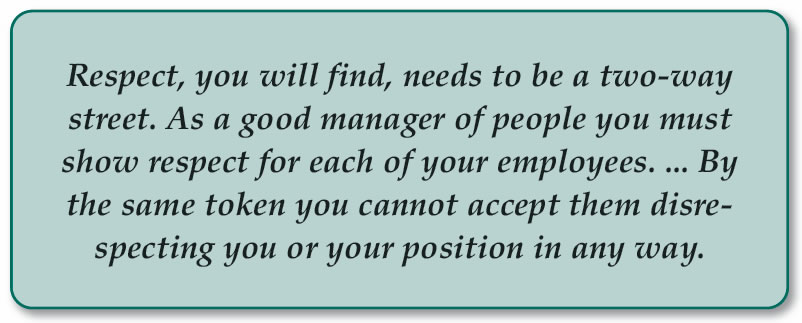

It’s Your Business
- Author: Terry Greenhut, Business Editor
- Subject Matter: Shop management
- Issue: The group must want to work for you
Shop management: First in a series
My next several articles will focus on managing your shop and its people. Even if you’ve been in the business for a long time and whether you are an owner, manager or a technician who aspires to someday move up in rank, management skills are one of the most important attributes of a successful business person. Since many of us in the transmission and auto repair business started out by turning wrenches, we weren’t formally trained for the management jobs we are trying to do today. So whether you are new to managing or have been doing it for a long time, boning up on management skills can be very helpful to your career.
By definition: Management is the skill of being able to plan, lead, communicate, control, and execute by using a group of people to successfully achieve the objectives of the company or organization. A manager is the person who guides, coaches, and controls another person or group of people focused on common goals or outcomes.
You probably became or are becoming a manager because you performed at a high level in non-management positions. In those jobs, you were the producer, the one who made the product or the repair. You were used to jumping right in and getting dirty, putting your hands on every phase of the operation. As a manager your role is to guide your people rather than do it yourself.
And if you don’t think it’s hard to keep your hands in your pockets and not jump in when you think you can do it better or quicker than your employees, you’re wrong. Practicing restraint is a big part of learning to be a good manager. Teaching and coaching rather than doing it yourself increases productivity in the long run because it allows for many to be able to do what you can, not just you. That initially costs some time and money but will eventually save a lot more of it.
As a manager of people one of your primary roles is that of a provider. You provide what they need to do their jobs the best they can. Whether it be in the form of tools, training, materials, positive reinforcement or even the occasional shoulder to cry on – you are there for them.
One of the primary goals of a manager is to learn as much about his or her people as is necessary to understand what it takes to motivate each of them as individuals and as a group to be as productive and as caring about the customers as possible in order to achieve a high level of profit for the company and insure good wages and benefits for all of its employees. It would be nice, and easy, if you could apply the same people managing technique to everyone in the group but you can’t because people are different.
What motivates one person to work better and faster doesn’t always mean a hill of beans to another or all of the others. That’s why each employee’s personality needs to be understood individually and dealt with based on their wants, needs, goals and capabilities, not yours. If you push too hard for employees to accept your values, techniques and the agenda of the company, the result can just as easily be negative as positive.

I had seventeen people working for me in two shops. I learned early on that each had to be dealt with differently if I wanted to get the most out of them. Some you could give a direct order to like an army drill sergeant would, and they immediately proceeded to carry it out. Others wouldn’t do it without an explanation. Some wanted everything written down for them while others could see the task in its entirety in their own minds.
While some needed to be told, others just instinctively knew what to do next. Some had to be asked nicely as if they were doing you a personal favor instead of doing their job. They didn’t respond at all to being told anything. Some pretended to know everything while others pretended to know nothing, especially if they were being assigned a job they didn’t particularly want to do.
I’ll never forget my first exposure to that “know nothing” type of behavior. It was when I was an elevator mechanic long before I went into the transmission business. We worked in teams. My partner Mike, our team leader, was a long-term veteran of the industry who knew how to do any job that was thrown at us. There was one job though that nobody would choose to do if that had the choice. It was called “re-roping” which meant changing all the cables, or as we called them “wire ropes” that ran from the elevator car to the counterweight and back. It was a very dirty and difficult job. It cut up your hands from the fish hooks that stuck out of the old worn cable, destroyed your clothes from all the grease that was imbedded in it, and might kill you if you fell down the shaft, which could happen because part of the job was to stand on a plank in the middle of the hatch several stories from the bottom of the shaft in order to guide and coil the old cable as it came down.
Every time we were assigned one of those jobs Mike would tell the boss that he didn’t know how to do it. Not a clue. Well, the boss only fell for that a couple of times. Then he got so angry when he found out that Mike was lying, for the next year, he gave our team just about every rope job that came in. So the risk of lying wasn’t worth it, but some employees continue to try it anyway.

Respect, you will find, needs to be a two-way street. As a good manager of people you must show respect for and to each of your employees. Some may be brighter than others, some may be faster, some more meticulous, some may be easier or harder to deal with, but each has value to you and to the company. Your goal would be best suited to celebrating the good things each employee brings to the table instead of criticizing what they don’t. By the same token you cannot accept them disrespecting you or your position in any way. If one person starts it and gets away with doing it others will join in because they will view the manager’s allowing it as a weakness. Before long all of them will do it, and a good portion of the manager’s authority will be gone, at which point it will be almost impossible to get consistent work out of any of them. A manager is judged on the productivity of his or her group, not so much on their personal achievements; so having the group want to work for you is very important.
Pro football players make good money. Their base pay is about $300,000 a year. Of course many of the superstars make considerably more. Whether they win or lose they will get paid, so why is it that some teams outshine others year after year? I always look toward the head coach, the supreme motivator. I believe that when the players trust in him and view him as truly their leader they play harder and better for him. They dedicate themselves not only to their own careers but to him as well. Take, for example, Bill Parcells, head coach of the New York Giants, the New York Jets, the Dallas Cowboys and the New England Patriots. Every team he coached was a winner. Why? Because his players wanted to play for him. They respected and maybe even loved him. He inspired and therefore got the most out of them.

If you want a winning team that’s what you need to do as well: Be their inspiration. Lead them into battle. Be there for them. Show them that you are the genuine article, someone who knows exactly what he or she is doing. Let each employee know what is expected of them. Be their teacher and their leader. Fight for what they need to do their jobs.
The way you conduct yourself in front of your employees makes a big difference. For example, screamers don’t get respect. They lead through fear and intimidation. Employees don’t follow them out of love or respect, but out of fear of retribution if they don’t. That type of manager can’t rely on his or her people always telling the truth about any situation in the shop. They will keep secrets rather than be yelled at for passing along any bad news.
Your choice of language is important. The less curse words you use the better. You want to show that you have a certain amount of class. If you are easily rattled, go into little fits of rage when things go wrong or start cursing like a sailor your employees won’t respect you.
Tip: Don’t try to be one of them. It’s good to show them that you know their job, if you do. It’s not good to become their best friend or go out socializing or drinking with them after work. In fact, if you ever have to attend an event at which alcohol is served you would be wise not to drink at all. It can lead to very stupid things coming out of your mouth, things employees might use against you at some later date. It’s also a good idea to leave the party early, before others drink too much and start telling you what they don’t like about you or the company.
Be sure to practice what you preach. If you want employees to be on time make sure you are. If you want them to give the best possible customer service make sure they see you doing it. Never blame anything on the customer in front of your employees or they will start doing it as well. It’s not the customer’s fault that the work you did came back. He didn’t set out to break what you just fixed. It happens. Just take care of it and be nicer to him now than when you were taking his money. If your employees see that, hopefully they will treat your customers the same way.
As their manager you take on several roles, in the eyes of your employees, and they expect you to fulfill every one of them. The more of them you can, the more productivity you will get.














